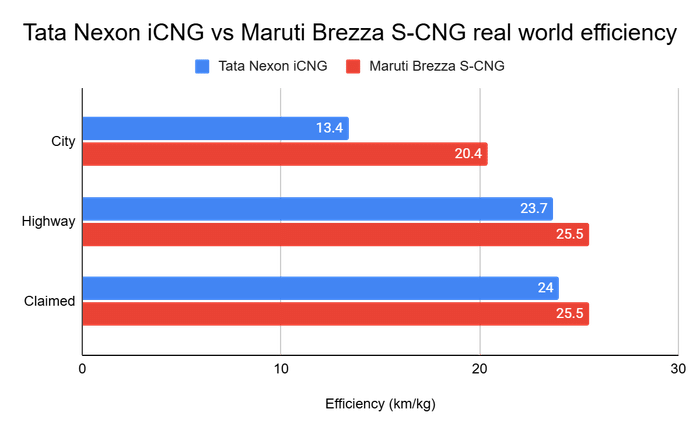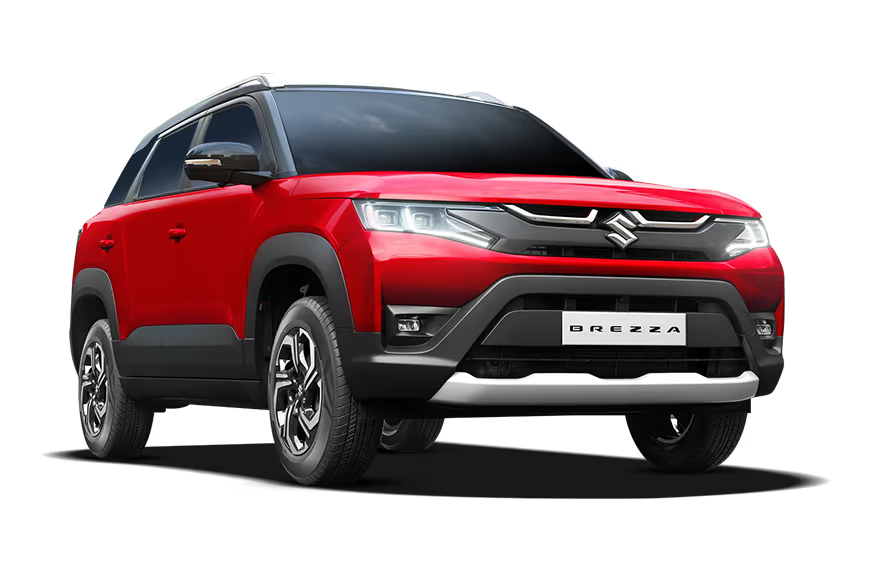Tata Nexon CNG vs Maruti Brezza CNG real world efficiency compared
We put these two popular compact SUVs to the test to find out which is more efficient.
Published On Feb 06, 2025 08:00:00 AM
29,017 Views
Follow us onTata Motors has broadened the Nexon’s appeal with the iCNG version, which is sold alongside its turbo-petrol, diesel and electric iterations. Priced between Rs 9 lakh and Rs 14.60 lakh, the iCNG is offered across a wide price band. Uniquely, it is the only offering in the market that marries a turbo-petrol engine with CNG (compressed natural gas) and comes paired with a 6-speed manual transmission.
To find out how efficient the Nexon iCNG is in the real world, we compare it to its direct, well-established rival, Maruti Brezza S-CNG, which is priced between Rs 9.29 lakh and Rs 12.09 lakh.
- Neither is equipped with an auto engine stop/start or drive modes
- Top-spec Nexon is 143kg heavier than the Brezza
- Nexon gets a 60L CNG tank, while the Brezza's is 55L
The Nexon iCNG, with its turbo-petrol + CNG combination and a 6-speed manual transmission, is claimed to deliver 24km/kg, whereas the Maruti Brezza S-CNG, with its 1.5-litre naturally aspirated petrol + CNG combination and a 5-speed manual, is claimed to deliver 25.51km/kg. In our city fuel efficiency test, the Nexon returned 13.4km/kg, while the Brezza’s 20.4km/kg came across as rather impressive. Notably, in stop/go conditions with constant on-boost and off-boost scenarios, the Nexon’s turbo-petrol mill takes a toll on its efficiency. Further, there isn’t an auto engine stop/start tech or an Eco drive mode to keep a check on gas consumption.

On the highway, both cars achieved an efficiency closer to their respective claimed figures. The Nexon delivered 23.7km/kg, while the Brezza delivered 25.5km/kg. The Nexon’s sixth gear makes it an easy-sipper while cruising on the open road, spinning at around 2,300rpm at 100kph in sixth gear; the Brezza’s engine spins at around 2,900rpm in fifth gear. However, the Brezza’s 1.5-litre unit is inherently more efficient, and its lighter kerb weight of 1,255kg (Nexon’s is 1,398kg) helps deliver taller fuel efficiency.
Autocar India’s fuel efficiency testing
CNG tanks are trickier to fill, and there are several variables, particularly ambient temperature and pump pressure. So, we didn't opt for our standard tankful-to-tankful methodology. For our real-world test, we emptied their CNG tanks and filled each of them with 2 kilograms of CNG. Then, we drove them within urban confines till they ran out of gas. We repeated the process for the highway test. Throughout the drive, these cars were driven in CNG mode only.
Tyre pressures were maintained based on the manufacturer’s recommendation. These cars were driven on fixed city and highway loops in and around Navi Mumbai, maintaining certain average speeds. Throughout the tests, there was only one person in each car who ran the aircon and other electricals, such as the audio system, indicators and wipers, when required – just like a regular user would. Periodic driver swaps further neutralise variations in driver patterns. We take pride in our testing data, which isn’t merely consistent but also gives users an accurate indication of what they can expect in the real world.
Also See:
Real-world range tested: EVs under Rs 25 lakh
Hyundai Alcazar diesel real-world fuel economy tested, explained
Copyright (c) Autocar India. All rights reserved.

.jpg?w=700&c=1)




Comments
Member Login
Personal Details
No comments yet. Be the first to comment.